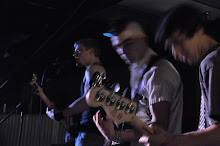As I stated in the previous entry, this movie is very fast paced. What makes it fast paced is mostly due to the way it is edited. It cuts scenes together in such a way that makes the viewer feel like they need to keep up and pay attention or they may miss something. I know that as I was watching the movie, I wanted to take notes but at the same time did not want to look away for fear of missing an important scene. The opening scene itself contained creative editing. The crowd of people sped up and blurred while one character that was in the movie stands out in real time and in crystal clear color. The scene would then dissolve into the next where another character would stand out in the crowd. Another place where dissolve and color change are used is both times someone dies before the movie "re-starts." After the character is fatally wounded, the scene dissolves to a red screen and goes to Lola and Manni lying in bed still entirely red. It then dissolves back to true color and the sequence re-starts.
This leads me to another editing technique that helps this re-starting aspect. When the bag of money is either thrown up or dropped, the scene is cut back to an earlier scene of Lola carelessly throwing her red phone up in the air and landing perfectly on the hook. Each time, the phone slams on the hook before the bag hits the ground signifying that before the character dies life is re-started. This leads into Lola's constant running scenes. There are many different edits and cuts while Lola is running in order to show how far she has gone in a shorter amount of time than reality. There are times when Lola is running and the camera is in front of her then it quickly cuts to behind her as if she has just ran through the camera. Other times it cuts from the front to the side to give a better picture of where she is actually running. Another edit that I particularly like is when Lola is shot from the side at one location and then suddenly is cut to another location almost running in the exact same rhythm.
Another important edit is when we encounter the minor characters whose lives change drastically with each re-start. Each time we see these characters, the details of there near future are revealed with still frames. These still frames are transitioned by flashing lights as if from a camera flash. This gives the impression that these people's lives are being documented for our viewing. One other edit is at the beginning when Manni is explaining his situation to Lola. He tells her that the bum who stole his money is probably on a plane to somewhere far away. He begins to list foreign places all around the globe and as he does the scene cuts from location to location. This is somewhat confusing because as the viewer you have to determine if these places are where the homeless person actually ran to or if these other countries are involved at all.
One final scene that I will comment on is when the clock is about to strike twelve noon. At this point, Manni is about to walk into the grocery store to rob it while Lola is around the corner about to appear. At this point the scene wipes to Manni watching the clock on the left , Lola running on the right, and a clock ticking at the bottom of the screen. This shows clear time continuity and relativity. This technique is also used during the third "try" except with Lola's father in the frame on the left instead of Manni.
Overall, I enjoyed the way this movie was edited. These editing techniques make me have to imagine what takes place in the gaps that are left by the quick cuts. The transitional devices such as cuts, wipes, and dissolves really help give the movie an aspect of being rushed and panicked. This movie is all about timing and patience and the editing certainly can attest to both these ideas.
Thursday, October 15, 2009
Subscribe to:
Post Comments (Atom)

No comments:
Post a Comment